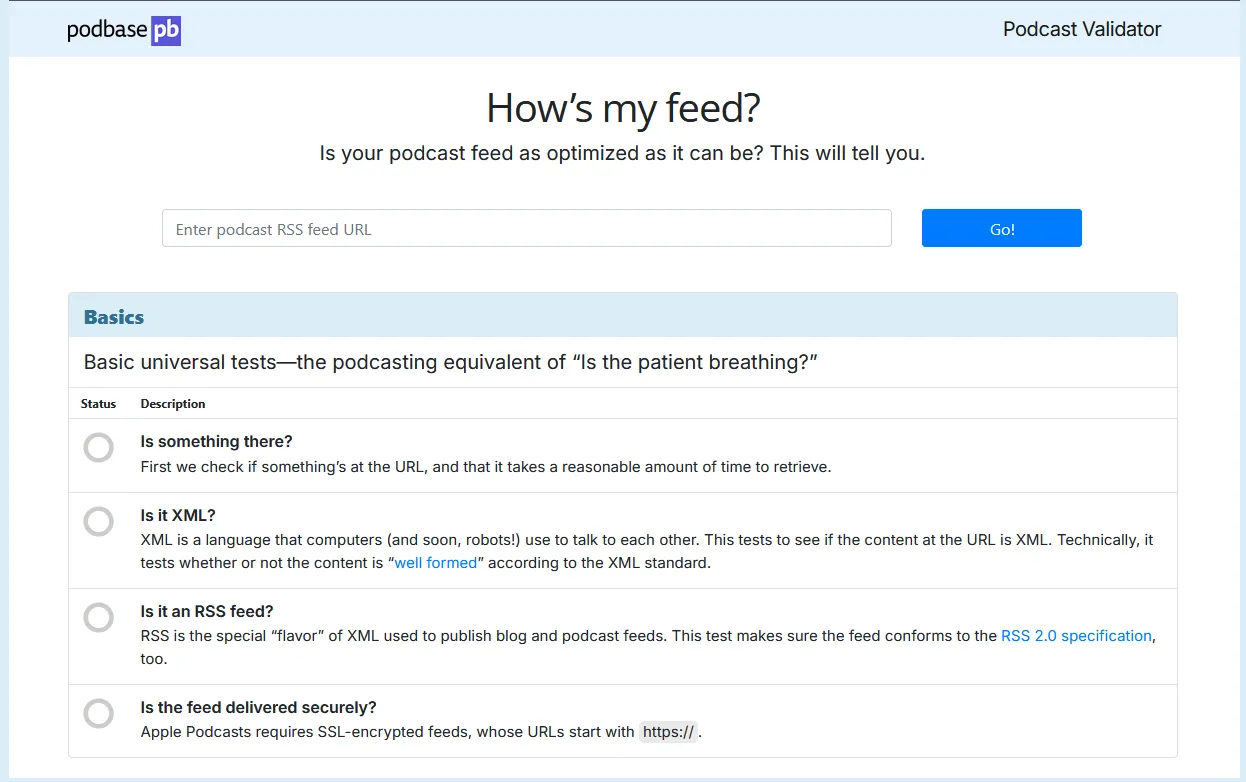How to Create an RSS Feed for Your Podcast

RSS feeds are the backbone of podcast distribution, allowing podcasters to syndicate their episodes across multiple platforms automatically. Whether you want to reach audiences on Apple Podcasts, Spotify, or Google Podcasts, having a properly configured RSS feed means that your new podcast episodes will get published and discovered, without you having to chase down your listenership on your own.
We’ll walk you through the entire process of creating and setting up your RSS feed, from understanding how they work to making sure yours is all ready to serve your amazing new podcast!
What Exactly is a Podcast RSS Feed?
RSS stands for “Really Simple Syndication,” and uses an XML format (an internet markup language used to store and transport data) to distribute updates from a website or podcast.
A podcast’s RSS feed contains all the important metadata for a podcast, including the title, description, episode details, and media URLs. Podcast directories read the RSS feed to automatically pull new episodes when they are published, ensuring that your content is always up to date, and your new podcasts are ready to go for your listeners.
How Does an RSS Feed Work?
A podcast RSS feed allows a single source, such as your hosting provider, to distribute your podcast episodes to multiple platforms, for instance Apple Podcasts, Spotify, and Google Podcasts.

When you upload a new episode, the hosting platform updates the RSS feed, and podcast platform directories pull this update to display new episodes to your audience. This automation saves time for podcasters and streamlines the process, ensuring that all platforms receive your podcast’s latest episodes.
Does Your Podcast Require an RSS Feed?
If you want your podcast to be heard, yes! Having an RSS feed is essential for podcast distribution. Without an RSS feed, your podcast can’t be listed on major platforms like Apple Podcasts, Spotify, or Google Podcasts, so your listenership will be extremely limited.

RSS feeds also improve discoverability by ensuring your episodes are accessible across the aforementioned platforms, which allows you to grow your audience. Then, once your audience is established, you can build a community around your podcasts, from your socials to your merch store on a platform like Fourthwall, where you can customize everything from T-shirts to mugs to podcast logo stickers!
Everything You’ll Need for Your Podcast RSS Feed!
There are a number of elements you’ll need to set up for your podcast RSS feed that will help directories categorize and display your podcast correctly.
Podcast Listing Details
- Title and description - choose a catchy title and write a concise yet compelling summary of your podcast to attract listeners! Keep SEO in mind while writing these, to help with searches and engagement.
- Category selection - categorize your podcast appropriately to further assist searches and recommendations.
- Cover artwork - create a high quality image for your podcast, typically between 1400x1400 and 3000x3000 pixels, in PNG or JPEG format.
Additional Podcast Info
- Host information - include your name or your brand’s name to establish authenticity.
- Publish date - to ensure chronological organization of your episodes.
- Copyright and author details - these are necessary to credit and protect your work.
- Language and explicit content indicator - these are required for audience filtering and content warnings.
Technical Requirements
- Audio file URL - to provide direct access to your episode(s) for streaming and downloading.
- Audio file size - to maintain compatibility with podcast directories, your audio files should be in MP3 format with a recommended bitrate of 128-320 kbps for optimal quality. Keep episode file sizes under 100MB to ensure efficient streaming.
Validation - to verify that your RSS feed is functioning properly, use tools like Cast Feed Validator or Podbase to check for errors and ensure that everything is formatted correctly.

Follow These Steps to Create an RSS Feed for Your Podcast
1. Choose a Hosting Platform
Select your podcast hosting platform of choice to generate and manage your RSS feed. There are several options available, each with unique benefits.
- RSS.com is an affordable platform that offers automatic distribution to major directories.
- Spotify for Creators (previously Anchor) provides free hosting with built in monetization options, which makes it ideal and fairly easy to use for beginners.
- Buzzsprout is known for its user friendly interface and high quality analytics.
- Podbean offers strong monetization and live streaming features.
- Libsyn is a trusted choice for professional podcasters with some experience who require stable, reliable hosting.
2. Create Your Content!
Presuming you’ve got your content all planned out, it’s time to record! Recording high quality audio is essential to get a professional sounding podcast. Start with a good microphone, like a Rode NT-USB or the popular Shure SM7B, to ensure audio clarity; and then make your choice of recording software.
Some options for software include Adobe Audition, Audacity, or GarageBand (Apple.) Each offers a range of editing features for your sound; you can use noise reduction filters to remove background sounds; normalize volume levels for consistent overall sound; and even add intro and outro music to establish your brand identity.

3. Upload Your Podcast Files
Once your podcast is recorded and edited, it’s time to upload the audio file to your hosting platform. The standard format for podcast audio is MP3 with a sample rate of 44.1 kHz to ensure compatibility across all platforms.
You’ll also want to note your bitrate, which can upscale or downscale depending on the type of podcast: 128 kbps is suitable for spoken word content, while 192-320 kbps is recommended for more high quality, complex audio. Before uploading, make sure your audio file includes metadata such as the episode title and artist name in the ID3 tags, and keep filenames structured, for example “PodcastName_Episode01.mp3,” to keep your episodes organized. You can also schedule episodes in advance to maintain a consistent publishing schedule.
4. Add Episode Details
Adding detailed metadata makes certain that your episodes are easy to find and categorize. Enter a clear and engaging episode title for your podcast, and write an intriguing description using relevant keywords; include appropriate tags and categories to help with searchability and recommendations.
You might also consider show notes, which can provide additional value to listeners and give your podcast a more upscaled vibe. Show notes can include timestamps for key topics, links relevant to your content or discussion, and CTAs for your social media accounts. These notes provide useful resources for your audience, and can really help with engagement.
5. Add Your Podcast RSS Feed to Directories
Submitting your RSS feed to the major podcast directories helps your podcast reaches the widest audience possible. The best known and most used podcast platforms include:
- Apple Podcasts - Sign up via Apple Podcasts Connect.
- Spotify - Submit via Spotify for Podcasters.
- Google Podcasts - Use the Google Podcasts Manager.
- Amazon Music and Audible - Submit through their podcast submission page.
- iHeartRadio, TuneIn, Pandora, and YouTube - each of these requires a one time RSS feed submission.
3 Best Practices for Creating Your RSS Feed
1. Validate Your RSS Feed
Ensuring that your RSS feed is correctly formatted and optimized will help your podcast run smoothly and be more discoverable. An improperly formatted RSS feed can cause issues when submitting to podcast directories or prevent episodes from being updated correctly.
To avoid these problems, use tools like Cast Feed Validator or Podbase to regularly validate and check your podcast for errors; these tools will analyze your feed and alert you to missing metadata, broken links, or invalid podcast formatting.
2. Maintain Consistent Metadata
Metadata plays a big role in how podcast platforms categorize and display your podcast episodes. To maintain consistency, use a standardized, consistent naming format for your episodes - for instance “PodcastName_Episode01.mp3” - this will keep your files organized, easy to locate, and easy for platforms to index.
Also keep SEO in mind - including relevant keywords in episode titles and descriptions can improve search visibility and help potential listeners find your podcast. Also make sure that all metadata fields, such as author name, copyright information, and episode descriptions, are consistently formatted, so your podcasts keep a professional and cohesive look.
3. Publish Consistently
One of the most effective ways to grow an engaged audience is by maintaining a regular podcast episode release schedule. While it helps to publish episodes fairly frequently, it’s even more important to publish on the same day/time each week or month. Sticking to a predictable schedule helps your audience build listener habits, and encourages them to look forward to your next episode. Many podcast hosting platforms allow you to schedule episodes in advance, which is useful for maintaining consistency even when you’re busy.
Maximize Your Podcast Revenue with Fourthwall
Fourthwall gives podcasters powerful tools to monetize their audience beyond just their podcast episodes alone! With Fourthwall, you can sell custom merchandise, offer exclusive content to your loyal listeners, and create an amazing branded storefront that showcases your podcast and products in one place.
.webp)
Whether you’re selling branded T-shirts, podcast logo mugs and stickers, or digital downloads, Fourthwall makes it easy to turn your listeners and fans into customers. By integrating Fourthwall into your podcast strategy, you can diversify your income streams and strengthen your connection with your audience, all while growing your brand. Ready to start selling? Set up your store with Fourthwall today and turn your podcast into a moneymaker!
















